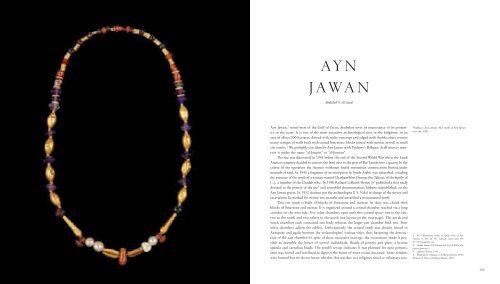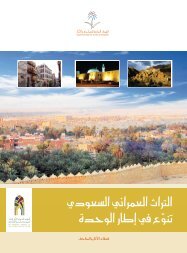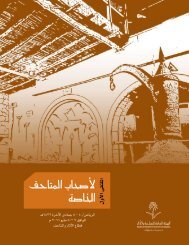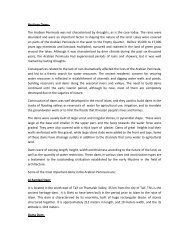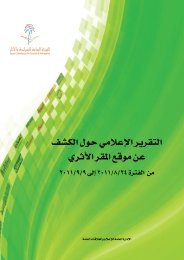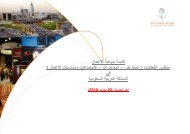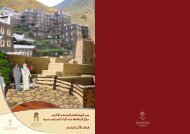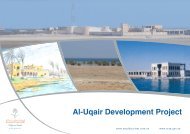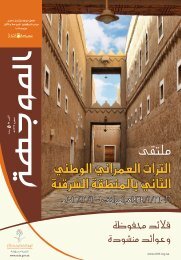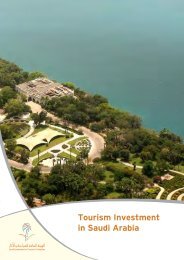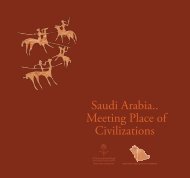Roads of Arabia
Roads of Arabia
Roads of Arabia
Create successful ePaper yourself
Turn your PDF publications into a flip-book with our unique Google optimized e-Paper software.
22 Arabie US p398-403_BAT.qxd 23/06/10 21:56 Page 398<br />
AYN<br />
JAWAN<br />
Abdullah S. Al-Saud<br />
Ayn Jawan, 1 north-west <strong>of</strong> the Gulf <strong>of</strong> Tarut, doubtless owes its importance to its proximity<br />
to the coast. It is one <strong>of</strong> the most extensive archaeological sites in the kingdom; in an<br />
area <strong>of</strong> about 200 hectares, dotted with rocky outcrops and edged with shabka, there remain<br />
many vestiges <strong>of</strong> walls built with coated limestone blocks joined with mortar as well as small<br />
cist tombs. 2 We probably can identify Ayn Jawan with Ptolemy’s Bilbana. Arab sources mention<br />
it under the name “al-Jounin” or “al-Jounan”.<br />
The site was discovered in 1943 before the end <strong>of</strong> the Second World War when the Saudi<br />
Aramco company decided to convert the land next to the port <strong>of</strong> Ras Tanura into a quarry. In the<br />
course <strong>of</strong> the operation the Aramco workmen found mysterious constructions buried under<br />
mounds <strong>of</strong> sand. In 1945 a fragment <strong>of</strong> an inscription in South Arabic was unearthed, revealing<br />
the presence <strong>of</strong> the tomb <strong>of</strong> a woman named Ghatham bint Oumrat ibn Tahiou, <strong>of</strong> the family <strong>of</strong><br />
[...], a member <strong>of</strong> the Chadab tribe. In 1950 Richard LeBaron Bowen Jr 3 published a first study<br />
devoted to the pottery <strong>of</strong> the site 4 and assembled documentation, hitherto unpublished, on the<br />
Ayn Jawan graves. In 1952 Aramco put the archaeologist F. S. Vidal in charge <strong>of</strong> the survey and<br />
excavations; he worked for twenty-two months and unearthed a monumental tomb.<br />
This cist tomb is built <strong>of</strong> blocks <strong>of</strong> limestone and mortar; its door was closed with<br />
blocks <strong>of</strong> limestone and mortar. It is organized around a central chamber reached via a long<br />
corridor on the west side. Five other chambers open onto this central space: one to the east,<br />
two to the south and two others to the north (see layout on the next page). The north and<br />
south chambers each contained one body whereas the larger east chamber held two. Four<br />
other chambers adjoin the edifice. Unfortunately the central tomb was already looted in<br />
Antiquity and again between the archaeologists’ various visits, thus hastening the destruction<br />
<strong>of</strong> the east chamber. In spite <strong>of</strong> these successive lootings, the excavations made it possible<br />
to assemble the bones <strong>of</strong> several individuals, shards <strong>of</strong> pottery and glass, a bronze<br />
spatula and carnelian beads. The tomb’s set-up indicates it was planned for nine persons,<br />
then was looted and reutilized to deposit the bones <strong>of</strong> more recent deceased. Some remains<br />
were burned but we do not know whether this was due to a religious ritual or voluntary acts.<br />
Necklace, 2nd century AD, tomb at Ayn Jawan<br />
(cat. no. 238)<br />
1. At 3 kilometres north <strong>of</strong> Qatif, west <strong>of</strong> Ras<br />
Tanura; at 26 o 42’ 46” latitude north and 49 o<br />
57’ 53” longitude east.<br />
2. Unlike those <strong>of</strong> al-Zahran and Ayn al-Sih in the<br />
eastern province.<br />
3. LeBaron Bowen 1950.<br />
4. Frederick R. Matson, in LeBaron Bowen 1950;<br />
Florence E. Day, in LeBaron Bowen 1950.<br />
399


